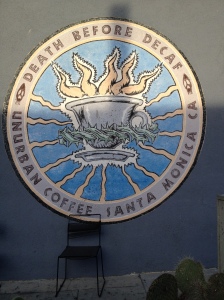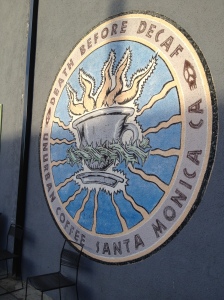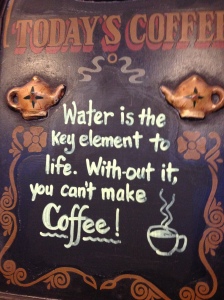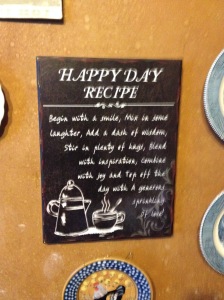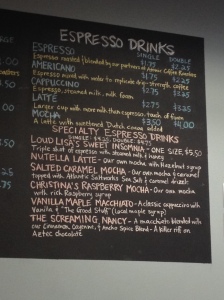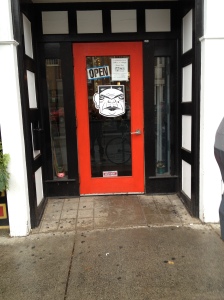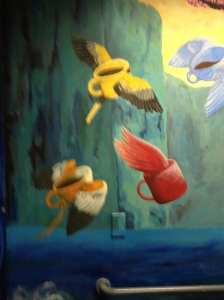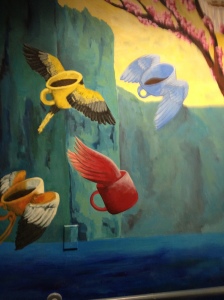Blog Archives
“Death Before Decaf – Is Coffee A Health Food?” by Gary S. Smolker
The “DEATH BEFORE DECAF” Sign which Inspired Me to Write This Post
I love to drink coffee in coffeehouses.
I firmly believe drinking coffee is good for me.
I make a point of traveling to as many coffeehouses as practical to sample coffee.
I look at all signs and messages posted and/or painted inside and outside of each coffeehouse.
Recently, I saw a sign on an exterior wall of a coffeehouse in Santa Monica, California (the Unurban Coffeehouse in Santa Monica, California) which I want to share with you because seeing that sign made me smile.
By the way, the Unurban Coffeehouse in Santa Monica is a bohemian type coffee house. The inside walls are covered with mismatched wallpaper, etc,
Below is a picture of a sign painted on an exterior wall of the Unurban Coffee house . This is the sign which inspired me to write this post.
Above is a picture of the Not-So-Secret-Menu of coffee drinks served at the Unurban Coffeehouse in Santa Monica, California.
The people who run the Unurban Coffeehouse are very clever.
Below is a picture of a sign I saw posted above one day old pastry.
By the way, I am a fan of coffee served right.
Also, I believe water is absolutely essential for life because coffee is made with water; see the sign below.
Preventing Aging and Cognitive Decline by Drinking Coffee
In “Grain Brain” by David Pearlmutter, MD., doctor Pearlmutter makes the claim that drinking coffee can be good for you with regards to living longer, avoiding or mitigating cognitive decline, and detoxifying your body.
Here is what I understand from reading Dr. Pearlmutter’s book “Grain Brain”:
- The brain generates tremendous amounts of free radicals.
- Our brain tissue is assaulted by these free radicals.
- We need to stimulate our body’s innate defense against free radicals.
- Our cells have their own innate ability to generate antioxidant enzymes on demand.
- Our DNA can actually turn on the production of antioxidants in the presence of specific signals, and this internal antioxidant system is far more powerful than any nutritional supplement.
- High levels of free radicals turn on a specific protein in the nucleus called Nrf2, which essentially opens the door for the production of a vast array of not only our bodies’ most important antioxidants, but also detoxification enzymes.
- In addition to antioxidant function, activation of the Nrf2 pathway turns on genes to produce a vast array of protective chemicals that further support the body’s detoxification pathways while dampening inflammation – all good things for brain health.
- Coffee is one of the most powerful Nrf2 activators in nature.
- Several molecules in coffee, some of which are partly present in the raw material while others are generated during the roasting process, are responsible for this positive effect.
- Far from being entirely dependent on external food sources of antioxidants, our body can produce antioxidants on its own.
That is one of the reasons why I drink regular coffee every day.
Another reason why I drink regular coffee every day is that it keeps me alert.
Is It Time to Switch from Coffee to Tea
I don’t know the answer to that question.
But here is a summary of what Dr. Perlmutter says about natural compounds that turn on antioxidant pathways through activation of the Nrf2 system.
Several natural compounds that turn on antioxidant and detoxification pathways through activation of the Nrf2 system have been identified. Among these are curcumin from turmeric, green tea extract, silymarin (milk thistle), bacopa extract, DHA, suforaphane (contained in broccoli) and ashwaganda. Each of these substances is effective in turning on the body’s innate production of key antioxidants, including glutathione.
Glutathione is regarded as one of the most important detoxification agents in the human brain. It serves as a major antioxidant in cellular physiology, not only helping to protect the cell from free radical damage, but also protecting the delicate and life-sustaining mitochondria. Glutathione is so important as an antioxidant that scientists often measure cellular glutathione levels as an overall indicator of cellular health.
Glutathione is a powerful factor in detoxification chemistry as well, binding to various toxins to render them less noxious. Most important, glutathione serves as a substrate for the enzyme glutathione S-transferase, which is involved in transforming a multitude of toxins, making them more water soluble and thus more easily excreted.
Is Coffee A Health Food?
In “The Virgin Diet”, JJ Virgin says:
“I fight with my fellow nutritionists often about this. I believe that coffee is a health food – in the right amounts. It is a very rich antioxidant crop. But the right amounts are critical: 1 or 2 cups is great, 5 cups is a problem, and a whole pot of coffee is a big problem.
“Buy organic coffee. Coffee beans are a very pesticide-laden crop.”
On the other hand, in “Eat to Live”, Joel Fuhrman, M.D. says:
- Excessive consumption of caffeinated beverages is dangerous.
- Caffeine addicts are at a higher risk of cardiac arrhythmias that could precipitate sudden death.
- Coffee raises blood pressure as well as cholesterol and homocysteine, two risk factors for heart disease. [ASIDE: I am not convinced that scientists know whether high or low cholesterol level is a risk factor for heart disease. Nor, am I convinced that taking a statin to lower my cholesterol level is of more benefit than detriment.]
- Caffeine is a stimulant that allows you to get by with less sleep and reduces the depth of sleep. Such sleep deprivation results in higher levels of stress hormone cortisol and interferes with glucose metabolism, leading to insulin resistance. Insulin resistance and subsequent higher baseline glucose level, further promotes heart disease and other problems.
- Adequate sleep is necessary to prevent overeating. There is no substitute for adequate sleep.
- Caffeine-withdrawal headaches and other withdrawal symptoms drive caffeine addicts to eat more to suppress caffeine-withdrawal symptoms. Thus they are prodded to eat more food that they would if they were not addicted to caffeine.
- You will never be in touch with your body’s true hunger signals while you are addicted to stimulants.
- It takes four to five days for the caffeine-withdrawal headaches to resolve once you stop drinking coffee.
- For some people, giving up coffee is more difficult than following dietary restrictions.
- Higher amounts of caffeine do not make it easier to control your appetite and food cravings; they make it harder.
By the way, I know a woman who doesn’t drink regular coffee because the caffeine or something else in regular coffee gives her migraine headaches and makes her unable to sleep at night.
PERSONAL OBSERVATIONS:
- If I am hungry when I wake up in the morning and drink a cup of coffee instead of eating, drinking coffee suppresses my hunger.
- Drinking coffee in the morning makes me feel alert and energetic and seems to make me think more clearly and faster.
The Power of Coffee to Heal and Protect Your Health
In his book “Brain Maker” Dr. Perlmutter ties the consumption of coffee to better health by the positive effect coffee has in promoting the health of good bacteria in your gut, in your stomach.
According to Dr. Perlmutter the diversity of gut bacteria regulates how much inflammation occurs in the body: Healthy levels of a variety of good bacteria limit the production of inflammatory chemicals in the body and the brain.
According to Dr. Perlmutter, inflammation is the basis of degenerative conditions in the body, including diabetes, cancer, heart disease and Alzheimer’s disease. Laboratory research unambiguously shows that through the workings of the belly’s bugs, coffee reduces the risks of type-2 diabetes, strokes, Alzheimer’s disease, Parkinson’s disease, and even cancer and cardiovascular disease. It does this through a variety of mechanisms that include the gut bacteria.
For starters, intestinal bacteria can easily digest the coffee-bean fiber that remains in brewed liquid, extracting its energy for their own growth and health. It also has been shown to reduce the ratio of Firmicutes bacteria to Bactericides; this shift in ratio is associated with reduced risk for diabetes and obesity, and, therefore, reduced inflammation
What’s more, according to Dr. Perlmutter: Coffee is a rich source of polyphenols, molecules with known healthful properties. Polyphenols are the most abundant antioxidants in the human diet.
Polyphenols are not only found in coffee; they permeate red wine.
The ability of your body to extract and use the polyphenols you consume is dictated largely by the gut bacteria. Those bugs take center stage in coordinating your biology for the benefit of your health.
In order to fully gain the health benefits of polyphenols from the foods you eat, you need a healthy microbiome.
Your microbiome is the vast population of organisms that live in your body and outnumber your cells ten to one.
The balance and diversity of gut bacteria regulates how much inflammation in the body.
Healthy levels of good bacteria limit the production of inflammatory chemicals in the body and in the brain.
How Much Coffee Do You Need to Drink to Get These Benefits?
Everybody is different.
I assume drinking coffee will effect everyone differently.
I assume drinking coffee will benefit some people and harm other people.
I know a woman who doesn’t drink coffee because drinking coffee gives her a migraine headache and makes it impossible for her to sleep at night.
For me personally, based on what I have read and how I feel when I drink coffee, I am going to “bet” drinking three to five cups of coffee a day will be ideal.
For me there is a social aspect to drinking coffee.
I love to be in coffeehouses.
I love to have coffee with friends.
Coffeehouses have a rich house as being a meeting place, as a place where people talk to each other, as a place where people come together as a community.
I love to sip coffee as I work early in the morning.
Below are a couple of signs I saw posted in a coffeehouse in June Lake, California in October, 2015, a little more than a month ago.
These signs made me smile when I first saw them and still make me smile.
The most creative coffee menu I’ve seen so far was a menu I saw a week or so ago on a chalk board on the wall of “The Ugly Mug Dinner” in Salem, Massachusetts.
Below are copies of a photo I took of that menu, of a photo I took of the front window of “The Ugly Mug Dinner”, and of a photo I took of the front door to “The Ugly Mug Dinner.”
The walls in the bathrooms of “The Ugly Mug Dinner” have a coffee mug motif.
Below are pictures of one of the walls in one of the bathrooms in “The Ugly Mug Dinner.”
Good Luck Finding Your Own Answer to the Question: “Is Coffee A Health Food?”
By the way:
- Health information is a moving target. Recommendations today may change tomorrow.
- According to the June 2015 issue of the “University of California, Berkeley Wellness Letter” the newest update of the U.S. Department of Agriculture and the Department of Health and Human Services “Dietary Guidelines for Americans” [according to a February 2015 570 page preliminary report] will recommend that a moderate amount of coffee (3 to 5 cups a day, up to 400 milligrams of caffeine) can be part of a healthy diet because it is not associated with any long-term health problems and may actually reduce the risk of cardiovascular disease, diabetes and other conditions. Higher amounts could be problematic and children and teens are advised to limit or avoid high-caffeine products.
- Humans are “emergent systems” – they are constantly changing, developing and evolving.
- Health is constantly in flux.
- Drinking coffee will stain your teeth.
I don’t know if drinking coffee will be of net benefit you or be of more harm to you than benefit.
I don’t know if physicians know enough to be able to answer that question.
On December 18, 2015 I found a link to an article published by “Everyday Health” on AOL titled “9 Healthy Reasons to Indulge Your Coffee Cravings.”
That article begins with the statement, “There’s no need to feel guilty about your morning cup o’ joe. On the contrary: People who drink four or more cups of coffee a day have up to a 20 percent lower risk of melanoma than those who sip the dark stuff less often, according to a 2015 study in the ‘Journal of the National Cancer Institute.”‘
That article goes on to cite medical authority for the proposition that coffee may lower your risk of developing the following health issues: (1) Stroke; (2) Diabetes; (3) Stress – “Turns out the aroma may help minimize the effects of sleep deprivation on your body. A 2008 study published in the Journal of Agricultural and Food Chemistry found that when stressed-out, sleep-deprived rats simply smelled coffee, they experienced a trigger in gene activity known to protect nerve cells from stress-related damage.” (4) Tooth decay; (5) Parkinson’s disease; (6) Breast cancer; (7) Heart disease; (8) Throat and mouth cancers.
That article contains the following caveat: “Most health experts agree it’s wise to limit your intake to a few cups a day – that’s a standard 8-ounce mug, not the super-sized beverages many coffee shops offer. Overdoing it can lead to interrupted sleep or insomnia, stomachaches, a racing heart, nervousness, irritability, and nausea.”
In a memorable conversations with my favorite physician I made the following comment,
- “It seems to me that professional medical advice about how to prevent heart attacks is at the level of witchcraft practices by witch doctors or at a lower level.”
He replied:
- “That may be true. But, I rather be treated by a physician today than by a physician fifty years ago, and I rather be treated by a physician fifty years from now than by a physician today. We are making progress!“
My Current Personal Health Goals and What I Expect from My Physicians
My personal health goals for the past five years have been
- (1) to learn how to have a productive conversation with myself and my physicians; and,
- (2) to rise my personal awareness about the things I do today that will affect my health today, tomorrow and for the rest of my tomorrows.
Trying to achieve those goals has been very frustrating and very exciting.
I’ve spent the past five years educating myself about the human body, how it works and what physicians know about health topics of interest to me.
I would like my physicians to be Demi-Gods.
I know my physicians are not Gods or Demi-Gods.
I know only too well that my physicians are intelligent fallible human beings doing the best they can with what they know and how they use the time and energy they devote to their practice of medicine.
One More Fact
When babies are born prematurely (newbies), it is standard medical practice to give them a caffeine drip to get caffeine into their system.
It is necessary to get caffeine into their system to stimulate their brain stem which is not yet fully developed.
If that is not done (1) the brain will not tell the lungs to breath, (2) the baby will hold its breath until it dies from suffocation.
Copyright © 2015 Gary S. Smolker, All Rights Reserved

